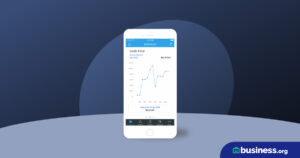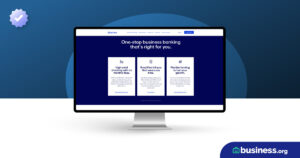💸 See if your business qualifies for a tax credit worth up to $26k per employee. 📞 Call Now: 855-979-9597
Ready to Sell on Amazon? Here’s a Quick Guide for Beginners
We are committed to sharing unbiased reviews. Some of the links on our site are from our partners who compensate us. Read our editorial guidelines and advertising disclosure.
Selling your product on Amazon can be a feasible option for any small-business owner. The sky's the limit when it comes to seller categories, and you don't have to invest much up front to start reaching customers.
Nearly 2 million small- to medium-sized businesses list their ecommerce businesses on Amazon—where millions of people shop each day. Even if you sell through your website, too, tapping into Amazon’s search functions and customer base could boost your brand.
We’ll explain your options for selling on Amazon and give tips on how to help your store stand out.
By signing up I agree to the Terms of Use and Privacy Policy.
How to sell on Amazon
There are three ways to sell products on Amazon:
- You can have Amazon fulfill orders by using Fulfillment by Amazon (FBA).
- You can fulfill orders yourself.
- You can do both for different products.
You’ll pay fees regardless of which way you go, but that’s where an FBA calculator comes in handy. You can figure out how much you’ll pay for FBA and compare that to your own fulfillment cost.
FBA (Fulfillment by Amazon)
FBA means that you send your products to Amazon’s warehouse, and they fulfill your orders and ship to your customers. You have to pay a monthly service fee and a monthly inventory storage fee. FBA fees are determined by the size and weight of your product, ranging from $3.22/unit to $158.49/unit. These fees include picking and packing an order, shipping and handling, customer service, and product returns.
These monthly fees might be worth it considering Amazon takes care of customer support and makes your FBA orders eligible for Prime status. For a more in-depth explanation, read our guide to Amazon FBA.
Bottom line: FBA may be a good fit for your business if you move inventory quickly, don’t have storage space, or don’t have the capacity to fill orders yourself.
Pro tip: FBA is best for products that are small, lightweight, and can be moved quickly and safely with little fuss.
FBM (Fulfilled by Merchant)
Amazon’s FBA option, your products are also not eligible for Prime status initially. You’re responsible to factor in both the time and energy required to get order shipped and delivered promptly. So while you trade Prime status for independence, this might be worthwhile depending on your needs right now.
FBM might be a better idea for business owners who are looking for more control over the customer experience too. By fulfilling and shipping yourself, you’re able to interact with the customer more during the transaction. These interactions might result in fewer returns and better reviews by satisfied buyers. You may even be able to add a note to say thank you for supporting your small business.
Outside of controlling the experience from cart to mailbox, FBM has other perks. If you have the space to store your products or are using a drop-shipping service, choosing FBM can save you a ton of money per unit sold.
Amazon charges storage and fulfillment fees depending on the size of your product—and you pay shipping on that product to get it to Amazon. FBA fees can get up to over $100 per unit. Fulfilling these items yourself can save money, especially if you’re launching a new product that may not sell as quickly.
Fulfilling your products by yourself also ensures that these oversized or fragile items are packaged and shipped responsibly. Amazon does ask merchants who choose the FBM option to fulfill orders following Amazon’s packaging requirements to the letter.
Bottom line: FBM may work well for your business if you sell a lower volume of inventory, have a heavy or large product, can process orders, and have space to store your inventory.
Hybrid approach to selling on Amazon
With a hybrid approach, you choose which products you want Amazon to fulfill (and be eligible for Prime) and which products you prefer to fulfill yourself.
The hybrid approach is best for merchants selling various products of differing sizes. Fulfilling larger items yourself can be more cost effective simply because shipping them to Amazon and paying for storage increases FBA fees.
For smaller or less fragile products, using Amazon’s FBA system might be perfect. You’ll pay less in fees and your product will be eligible for Prime, which can help you stay competitive.
Using both FBA and FBM is also a good option for merchants who sell some, but not all, items made to order. This approach lets you focus on creating high-quality, made-to-order items while choosing FBA for ready-to-order products.
Setting up an Amazon seller account
No matter how you choose to sell and fulfill your products, every merchant needs a seller account. You’ll need the following information to set up your Amazon seller account:
- Checking account
- Credit card
- Government-issued national ID (this could be your Social Security card, passport, or driver’s license)
- Tax identification number
- Phone number
Then you’ll need to select your selling plan in the Seller Central section
With each selling plan, you’ll have the option to add your products. If you’re not selling a unique product, you can use an existing listing to update your identical product details.
If your product is unique to your business, you can create a new listing which must include:
- SKU (stock keeping unit)
- Product identifier (GTIN, UPC, ISBN, EAN)
- Price, product condition, available quantity, and shipping options
- Product name, brand, category, description, and images
- Keywords and search terms

Sage HR offers an intuitive interface that visualizes employee schedules.
- Easily receive employee requests
- View schedules across numerous timeframes
- One-click time-off approval and easy schedule templates
How to make your Amazon listing stand out
To help your listing stand out, check out comparable products. As you scroll through, pay attention to who offers Amazon Prime, pricing, product descriptions, quality, etc. Knowing what your competitors offer may show you where you can match what they're doing or where you can improve.
Offer Amazon Prime
One simple strategy is to meet your competitors where they are in terms of shipping. If your competitors are offering Prime shipping and you’re not, this might be when you choose FBA instead of FBM. Your product will now be eligible for Prime and in the same league as the others.
Sponsored products
Another strategy is to consider making your listing a sponsored product. Sponsored products appear in search results and product listings. You’ll pay by the click, meaning you only pay when customers click on your listing.
The cost-per-click (CPC) is determined by how popular the keywords are in your listing. You’ll pay more per click to be higher on the page with an in-demand keyword and less per click to be farther down with a less popular keyword.
Your cost-per-click can be anything from 50 cents per click to several dollars. It all depends on your product and how much you’re willing to pay.
Get good reviews
The last and possibly most important tool is using reviews to their fullest. Good Amazon reviews can instill trust in a product, while a series of bad reviews can turn a customer to a competitor’s listing.
Encourage reviews in your listings and marketing. But make sure you don’t offer incentives or compensation for customers who do leave a review. That violates Amazon’s rules, and your listing could be removed or your business banned from selling on Amazon.
The takeaway
Choosing to sell on Amazon is a no-brainer. Making the biggest profit off your listings is an art. Choosing the right fulfillment plan, creating a competitive listing, and getting positive reviews can help your products stand out on one of the largest online marketplaces in the world.
Want some ideas for your ecommerce website? Check out our favorite ecommerce websites for small businesses.
Related content
Disclaimer
At Business.org, our research is meant to offer general product and service recommendations. We don't guarantee that our suggestions will work best for each individual or business, so consider your unique needs when choosing products and services.





